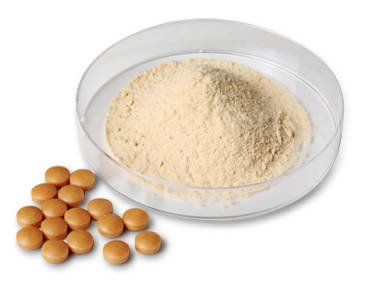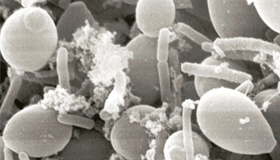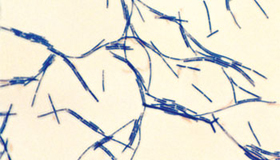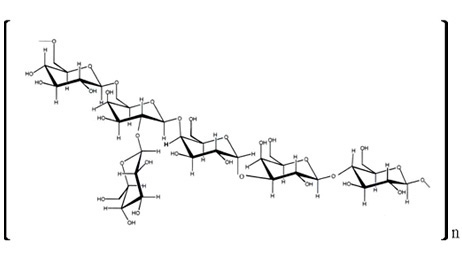
 Rice Kefiran is a novel, low-fat, highly functional food. Original Kefiran is the main component of kefir, a traditional fermented milk with historical roots in the Caucasus region. The people of Caucasus have been known for their exceptional longevity, which was attributed to this popular kefir drink. Kefir is a fermented milk beverage that is produced using a starter of yeasts and lactobacilli complexes, called kefir grains. Kefir contains alcohol, lactic acid, and carbon dioxide and has a distinct flavor which is appreciated in Eastern Europe and countries of the former Soviet Union, where 1.2 million tons of kefir are produced annually. Moreover, kefir is valued not only as a delicious beverage, but is also plazed as a macrobiotic food that helps to maintain and promote overall health. Rice Kefiran is a breakthrough Kefiran product made not from dairy, an animal source, but from rice, a vegetable source. Manufacturing Kefiran from a vegetable source is made possible only by Daiwa's state of the art biotechnology. To create Rice Kefiran, the lactobacilli, L.kefiranofaciens are separated from kefir and made into a pure culture in rice ingredients, thus enhancing the macrobiotic value.
Rice Kefiran is a novel, low-fat, highly functional food. Original Kefiran is the main component of kefir, a traditional fermented milk with historical roots in the Caucasus region. The people of Caucasus have been known for their exceptional longevity, which was attributed to this popular kefir drink. Kefir is a fermented milk beverage that is produced using a starter of yeasts and lactobacilli complexes, called kefir grains. Kefir contains alcohol, lactic acid, and carbon dioxide and has a distinct flavor which is appreciated in Eastern Europe and countries of the former Soviet Union, where 1.2 million tons of kefir are produced annually. Moreover, kefir is valued not only as a delicious beverage, but is also plazed as a macrobiotic food that helps to maintain and promote overall health. Rice Kefiran is a breakthrough Kefiran product made not from dairy, an animal source, but from rice, a vegetable source. Manufacturing Kefiran from a vegetable source is made possible only by Daiwa's state of the art biotechnology. To create Rice Kefiran, the lactobacilli, L.kefiranofaciens are separated from kefir and made into a pure culture in rice ingredients, thus enhancing the macrobiotic value.
The extraordinary combination of lactobacilli and rice creates a health food derived from Japan's staple food
Tomotari Mitsuoka
Professor Emeritus of the University of Tokyo
Doctor of Agriculture

A traditional type of sushi with a unique flavor, Narezushi, is produced in Japan by fermenting river fish in salt and a grain such as rice, to preserve the food. This is the precursor of modern sushi, and is an example of the excellent synergy between rice and lactobacilli. Until recently, lactobacillus (L.kefiranofaciens) has been cultured in milk, and typically, rice has not been the principal raw material for fermentation. A new, innovative technology uses bacteria and rice to produce Kefiran, a viscous polysaccharide.
As an expert in assigning the nomenclature and classification of lactobacilli, I am familiar with the challenge of large-scale culturing. I am pleased that large-scale cultivation is now available, making it possible for Kefiran to be incorporated into foods. It is remarkable to have opportunity to enhance people's health worldwide with the production of this novel food from Japan. My hope is that Rice Kefiran will become widely accepted based on its reputation for preventing lifestyle-related diseases.
The fermented milk, kefir, contains biogenic elements that directly affect metabolism and tissues, with other components that indirectly enhance biological functions by acting on intestinal bacteria. Examples of biogenic components are Kefiran (a viscous polysaccharide) and lactic acid. Examples of the other components are lactobacilli, their cell components, and bacteriocin, a type of antibacterial substance produced by lactobacilli. Kefir is an amazing food that has been reported to improve the intestinal environment and liver function, prevent arteriosclerosis, and strengthen immune function. These health benefits of kefir are thought to be derived from a functional component. However, making kefir widely popular in Japan has some slight problems: (1) kefir contains alcohol, (2) it produces carbon dioxide during storage, and (3) its flavor does not suit Japanese taste-preferences. If a new functional food ingredient could be developed from kefir with improved flavor and enhanced functional components, it is believed that it could become widely popular in Japan and throughout the world. With this in mind, the development of Rice Kefiran was advanced.
The lactobacillus L.kefiranofaciens, which forms the kefir grains, is thought to play a major role in the functionality of kefir. L.kefiranofaciens has been isolated from kefir grains, and was named by Japanese researcher Dr. Tomotari Mitsuoka.
The viscous polysaccharide Kefiran is believed to be the main functional component of the health drink kefir, and L.kefiranofaciens produces Kefiran. This homofermentative lactobacillus produces lactic acid only, so no alcohol or carbon dioxide is created. Thus, by using only L.kefiranofaciens for lactic acid fermentation, the problems with kefir were resolved, and its functionality is enhanced. Large-scale culturing of this bacterium is difficult and had been unsuccessful in the past, but with the assistance of Ministry of Agriculture, Forestry and Fisheries, Daiwa has developed a method of culturing the bacterium using rice as a source of nutrients by means of innovative technology that produces stable Rice Kefiran.

Scanning electron micrograph of the surface of kefir grains. Yeast and Lactobacilli coexist.
(“Science and Technology of Lactobacilli”, edited by Japanese Study Group for Lactic Acid Bacteria, 1996, Japan Scientific Societies Press)

Micrograph of Gram staining L.kefiranofaciens
(Daiwa Pharmaceutical Co., Ltd.)
• Has a high concentration of Kefiran, a viscous polysaccharide
• Is low in fat because it is made from fermented rice using lactic acid
• Contains no carbon dioxide or alcohol because it is a pure product of homolactic fermentation
• Is the first lactobacilli culture produced using L.kefiranofaciens
• Contains many amino acid-related substances derived from rice
| Rice Kefiran | Homemade kefir | |
| Kefiran content | 500mg or more | 2mg |
| Fat | < 0.5g | 2.8 – 3.3g |
| Alcohol | 0g | 0.6 – 1.1g |
400mg or more/day
The main functional component of Rice Kefiran is the viscous polysaccharide Kefiran. 100 g of Rice Kefiran contains 500 mg or more of Kefiran.
This is about 250 times the amount in 100 g of homemade kefir, which contains about 2 mg of Kefiran. Rice Kefiran also contains rice peptides, produced by lactobacilli, and gamma-aminobutyric acid (GABA).

Rice Kefiran is a water-soluble indigestible polysaccharide (a type of dietary fiber) which improves the intestinal environment and regulates blood lipids and blood sugar levels. In addition, Rice Kefiran contains GABA and rice peptides, which probably contribute to blood pressure and blood sugar regulation.
In addition to Kefiran's role as dietary fiber, the antibacterial effect of peptides produced by L.kefiranofaciens may also contribute to improving the intestinal environment. Animal studies using Rice Kefiran have detected a constituent sugar of Kefiran, known as galactose, in the serum lipid β-VLDL, indicating that some Kefiran is absorbed and utilized by the body.
| Single dose | LD50>5000mg/kg |
| Repeated dose | NOAEL>1000mg/kg/day |
|
Mutagenicity (Ames test) |
Negative with and without S9 mix |
Rabbit anti-Kefiran antibody is prepared, and a sandwich enzyme-linked immunosorbent assay (ELISA) is used to measure the amount of antigen corresponding to Kefiran-specific antibodies. The measured value indicates the weight of the functional ingredient.